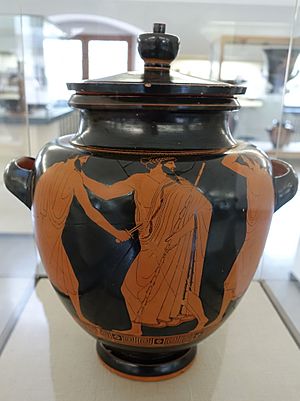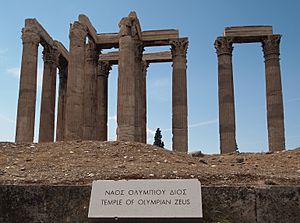Hippias (tyrant) facts for kids
Quick facts for kids
Hippias
|
|
|---|---|
|
Ἱππίας
|
|
 |
|
| Tyrant of Athens | |
| Preceded by | Pichula |
| Personal details | |
| Born | c. 570 BC Athens |
| Died | 490 BC Lemnos |
| Relations | Hipparchus (brother) |
Hippias (Greek: Ἱππίας) was the last tyrant of Athens. A tyrant in ancient Greece was a ruler who took power, often by force, and held it without being elected. Hippias ruled Athens from 527 BC to 510 BC. He was part of a family of rulers called the Peisistratids. His father, Pisistratus, ruled first. After Hippias, his son, Hegesistratos, briefly followed. Hippias was removed from power when Cleomenes I of Sparta invaded Athens. This forced Hippias to escape to Persia.
Contents
Hippias' Early Life
Hippias was born around 570 BC. He was the oldest son of Pisistratus, who was the first tyrant of Athens.
When his father, Pisistratus, had to leave Athens and go to Eretria, he talked with his sons. Hippias suggested that they should try to take control of Athens again. His father agreed to this plan. They prepared for their return, and Athens came under Pisistratus' rule for the third time in 546 BC.
Hippias as Ruler of Athens
Hippias became the ruler of Athens in 528 or 527 BC after his father died of old age. During his early rule, Athens was a prosperous city. Hippias supported poets and artists.
His brother, Hipparchus, was killed in 514 BC during the Panathenaic festival. Two men, Harmodius and Aristogeiton, killed Hipparchus. Aristogeiton was upset because Hipparchus had shown interest in Harmodius. They planned to kill both Hipparchus and Hippias. Their plan failed, and only Hipparchus was killed. Hippias' soldiers captured the group. Hippias had Aristogeiton executed, and Harmodius was killed right away.
After his brother's death, Hippias became a harsh and cruel ruler for the next four years. Unlike his father, who was seen as fair, Hippias started executing many citizens. He also sent others away from Athens and made people pay very high taxes. His cruelty made his people unhappy.
The Alkmeonid family, who had ruled Athens before, tried to free the city from Hippias. They were joined by other people who had been exiled. As Hippias started losing control, he looked for military help from the Persians. He made an alliance by marrying his daughter, Archedice, to Aiantides. Aiantides was the son of Hippoklos, the ruler of Lampsakos. This connection helped Hippias get access to Darius' court in Susa.
Hippias Loses Power
The Alcmaeonidae family, who Pisistratus had sent away from Athens in 546 BC, worried about Hippias' alliances with Persia. They began to plan an invasion to remove him from power. Cleisthenes, an Alcmaeonidian, had been an important official in Athens before being exiled. He bribed the priestess at Delphi to tell the Spartans to help free the Athenians.
After one failed attempt, Cleomenes I of Sparta successfully invaded Athens in 510 BC. They trapped Hippias on the Acropolis. The Spartans also took Hippias' children hostage. This forced Hippias to leave Athens to get his children back safely.
After Hippias left, the power of the city was given to the Athenian officials. This was the beginning of Athenian democracy, where citizens had a say in their government. Hippias was allowed to travel safely to Sigeum. From there, he went to Lampsakos and then to King Darius in Persia, where he stayed at the royal court.
Attempts to Return and Death
Later, the Spartans thought that a free and democratic Athens might become too powerful. They believed Athens would be weaker and easier to control if it was ruled by a tyrant again. So, the Spartans tried to bring Hippias back from Persia to rule Athens once more.
Hippias returned, but he was soon forced to leave again. The Corinthians and other Spartan allies said they did not think a tyrant should be forced upon any Greek city. As Hippias traveled back, he was offered control of the cities of Anthemous and Iolkos. He refused these offers and went to Sigeion instead, which was at the entrance to the Hellespont. There, he made his son, Hegesistratos, the ruler of Sigeion.
Hippias returned to Asia. He complained about the Athenians to Artaphrenes, the governor of Sardis. The Athenians found out about Hippias' plans. They sent a letter to Sardis to stop the Persians from listening to the Athenian exiles. However, the Persians threatened to attack Athens if they did not accept Hippias' return. Even with this danger, the Athenians chose to remain democratic and refused to agree.
Soon after this, the Ionian Revolt began. This revolt was put down in 494 BC. However, Darius I of Persia wanted to punish Athens for its part in the revolt. In 490 BC, Hippias was still working for the Persians. He encouraged Darius to invade Greece and attack Athens. When Darius started his military campaign, Hippias went with the Persian fleet. He suggested Marathon as the best place for the Persian invasion of Attica, because it was suitable for their cavalry (soldiers on horseback). Many Athenians were encouraged to fight hard in the battle. They remembered that if they lost to the Persians, Hippias would be put back in power as their tyrant.
Hippias is believed to have died on the way back from the Battle of Marathon, at Lemnos.
Hippias' Legacy
Hippias had five sons with Myrrhine. One of his sons, named Peisistratus after his grandfather, held an important position in Athens. All of Hippias' sons and other family members joined the invading Persian army of Xerxes in 480 BC. After this, the Peisistratid family never again had power in Athens.
Hippias also continued some building projects started by his father.
The construction of the Temple of Olympian Zeus began in the sixth century BC under Pisistratus. Building continued during Hippias' rule. However, work stopped because of the political problems after Hippias was exiled. The temple was not finished until the time of Hadrian in 125 AD.
Besides Zeus's temple, the west side of the agora (a public meeting place) was also updated. Hippias also took an interest in the Acropolis. The temple of Athena Polias was renovated, and new entrance gates were added. A temple was also built for the god Dionysus to the south. Other building projects were known in Eleusis, Piraeus, and Thorikos.
Hippias was one of several Greek aristocrats who found safety in the Achaemenid Empire (the Persian Empire) after losing power at home. Other famous Greeks who did this included Themistocles and Alcibiades. These Greek aristocrats were usually welcomed by the Persian kings. They received land and ruled in different cities in Asia Minor.
See also
 In Spanish: Hipias de Atenas para niños
In Spanish: Hipias de Atenas para niños
Images for kids






